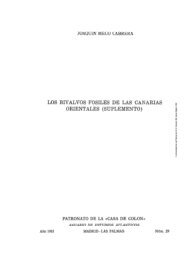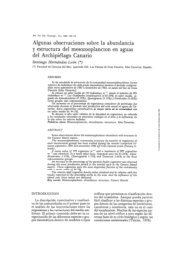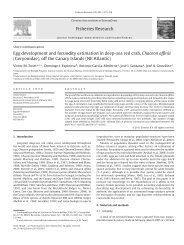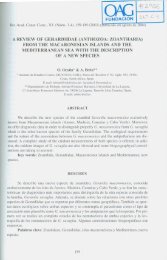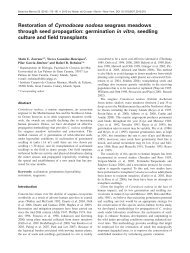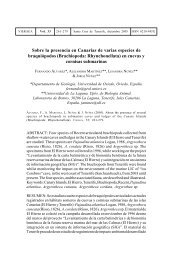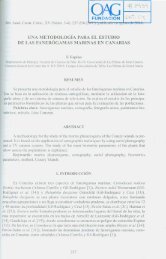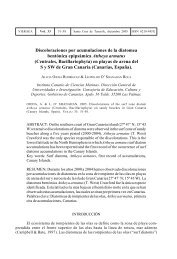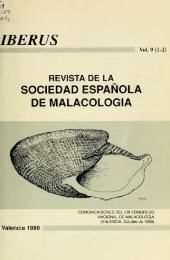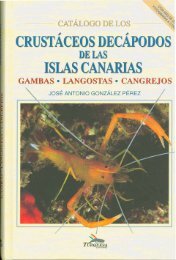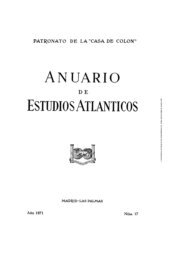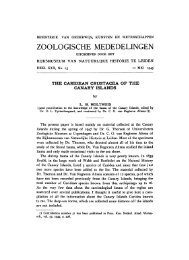of the madeira and selvagens archipelagos - redmic
of the madeira and selvagens archipelagos - redmic
of the madeira and selvagens archipelagos - redmic
Create successful ePaper yourself
Turn your PDF publications into a flip-book with our unique Google optimized e-Paper software.
man 1965 e referências neste artigo). Actualmente, acredita-<br />
-se que a população de Carduelis cannabina guen<strong>the</strong>ri possa<br />
ter aumentado e será interessante verificar se a distribuição<br />
futura da espécie irá seguir a predita. A modelação da distribuição<br />
mostra também que esta subespécie endémica está<br />
bem adaptada a habitats com influência humana.<br />
Carduelis chloris (Fig. 13c)<br />
Os resultados da distribuição de Carduelis chloris mostraram<br />
uma gr<strong>and</strong>e probabilidade de ocorrência da espécie<br />
em muitos quadrados contíguos, sobretudo a Sul da ilha.<br />
Este resultado está de acordo com a informação actual em<br />
relação à distribuição e abundância da espécie. O modelo<br />
não estimou a presença da espécie em áreas urbanas,<br />
como a do Funchal, onde é frequentemente observada em<br />
jardins. É interessante notar que, apesar de se acreditar<br />
que a população está a aumentar, todas as áreas que foram<br />
estimadas como sendo de gr<strong>and</strong>e probabilidade de ocorrência<br />
da espécie já estão ocupadas.<br />
Em geral, os resultados de modelação identificaram claramente<br />
muitas das áreas onde as três espécies ocorrem actualmente.<br />
Para além do mais, a modelação de Anthus ber<strong>the</strong>lotii<br />
madeirensis identificou outros locais onde a ave poderá<br />
ocorrer. Para a espécie Carduelis cannabina guen<strong>the</strong>ri foi<br />
corroborada a ideia de que as populações podem estender-<br />
-se para uma área de distribuição mais ampla de habitat favorável.<br />
Os resultados também confirmaram a ideia de que<br />
Carduelis cannabina e Carduelis chloris estão bem adaptadas<br />
a habitats alterados pelo Homem. Em alguns casos mais<br />
específicos, os resultados do modelo não são congruentes<br />
com os nossos dados de campo, apesar de não ser fácil<br />
identificar as razões que levam a essa incongruência.<br />
5. Conclusões<br />
Os modelos de predição da distribuição de espécies obtidos<br />
a partir do Maxent foram realizados com base em dados<br />
de presença de espécies, fornecidos por amostragens<br />
padronizadas (e.g. carabídeos), informação espacial da<br />
base de dados do ATLANTIS (e.g. moluscos) e informação<br />
de trabalhos publicados. Optámos por utilizar uma técnica<br />
de modelação que tivesse em conta apenas a presença das<br />
espécies, uma vez que não estavam disponíveis dados de<br />
ausência fiáveis para a maior parte das espécies. Com o<br />
uso desta técnica, aproximamo -nos da distribuição potencial<br />
da espécie com base na adequabilidade de diferentes<br />
áreas da ilha para determinados factores ambientais. Pelo<br />
contrário, a inclusão de variáveis de uso do solo desvia os<br />
resultados de uma distribuição potencial para uma distribuição<br />
real (i.e. onde a espécie efectivamente ocorre no<br />
presente). A posição exacta da distribuição de uma espécie<br />
neste gradiente entre os extremos de distribuição potencial<br />
e de distribuição real é, no entanto, desconhecida. A técnica<br />
do Maxent utiliza pseudo -ausências seleccionadas a partir<br />
dos dados de distribuição originais, uma abordagem que<br />
precisa de ser mais bem avaliada. Dado o pequeno número<br />
52<br />
Bannerman 1965 <strong>and</strong> references <strong>the</strong>rein). Nowadays, it is<br />
believed that <strong>the</strong> population might be increasing, <strong>and</strong> it will<br />
be interesting to see if <strong>the</strong> future distribution <strong>of</strong> <strong>the</strong> species<br />
will follow <strong>the</strong> prediction. From ano<strong>the</strong>r perspective, <strong>the</strong><br />
distribution modelling shows that this endemic subspecies<br />
is well adapted to humanized habitats.<br />
Carduelis chloris (Fig. 13c)<br />
The results <strong>of</strong> predictive distribution modelling for Carduelis<br />
chloris showed a high probability <strong>of</strong> species occurrence<br />
mostly in <strong>the</strong> south <strong>of</strong> <strong>the</strong> isl<strong>and</strong>, where many contiguous<br />
squares <strong>of</strong> high probability were identified. This<br />
agrees with current general information on <strong>the</strong> distribution<br />
<strong>and</strong> abundance <strong>of</strong> <strong>the</strong> species. The model failed to predict<br />
<strong>the</strong> presence <strong>of</strong> this bird in urban areas, namely Funchal<br />
where it is frequently seen in gardens. It is interesting to<br />
note that although <strong>the</strong> population is believed to be increasing,<br />
all <strong>the</strong> predicted areas with a higher probability <strong>of</strong><br />
occurrence are already occupied.<br />
In general, <strong>the</strong> modelling results have clearly identified<br />
many <strong>of</strong> <strong>the</strong> areas where <strong>the</strong>se three species occur. Fur<strong>the</strong>rmore,<br />
for Anthus ber<strong>the</strong>lotii madeirensis <strong>the</strong> model showed<br />
o<strong>the</strong>r locations where <strong>the</strong> bird can be found, <strong>and</strong> for Carduelis<br />
cannabina guen<strong>the</strong>ri <strong>the</strong> idea that <strong>the</strong> population can<br />
exp<strong>and</strong> to a much wider area <strong>of</strong> suitable habitat was corroborated.<br />
The findings also confirmed <strong>the</strong> idea that Carduelis<br />
cannabina <strong>and</strong> Carduelis chloris are two taxa well adapted<br />
to live in close association with habitats changed by humans.<br />
In relation to a few more specific aspects <strong>the</strong> findings<br />
<strong>of</strong> <strong>the</strong> model did not agree with our field knowledge, <strong>and</strong> <strong>the</strong><br />
reasons for this disagreement are difficult to identify.<br />
5. Conclusions<br />
Our Maxent models were done with presence data provided<br />
by st<strong>and</strong>ardised intensive surveys (e.g. ground beetles),<br />
spatial information provided by ATLANTIS database<br />
(e.g. molluscs) <strong>and</strong> data extracted from <strong>the</strong> literature. We<br />
decided to use a presence -only technique because reliable<br />
absence data were not available for most <strong>of</strong> <strong>the</strong> species.<br />
The use <strong>of</strong> such a technique implies that we are obtaining<br />
an approximation for <strong>the</strong> potential distribution <strong>of</strong> <strong>the</strong> species<br />
according to <strong>the</strong> environmental adequacy <strong>of</strong> <strong>the</strong> different<br />
areas <strong>of</strong> <strong>the</strong> isl<strong>and</strong>. On <strong>the</strong> contrary, <strong>the</strong> inclusion <strong>of</strong> l<strong>and</strong>-<br />
-use variables moves away from <strong>the</strong> potential distribution,<br />
<strong>and</strong> approaches <strong>the</strong> true distribution (i.e. where <strong>the</strong> species<br />
is actually present). As a consequence <strong>the</strong> exact position<br />
in <strong>the</strong> gradient defined by <strong>the</strong> potential -realised extremes<br />
is unknown. Maxent uses pseudo -absences selected from<br />
<strong>the</strong> background data, an approach that deserves a more<br />
critical evaluation. Because <strong>of</strong> <strong>the</strong> low sample sizes, no<br />
model could be evaluated with external data; instead, we<br />
preferred to use all <strong>the</strong> available information for <strong>the</strong> training<br />
process. Raes & Steege (2007) have recently proposed a<br />
technique that avoids <strong>the</strong> need to divide <strong>the</strong> original data



